This jalapeño cheddar sourdough bread recipe makes a crusty artisan loaf, loaded with cheddar cheese and spicy pickled jalapeños.
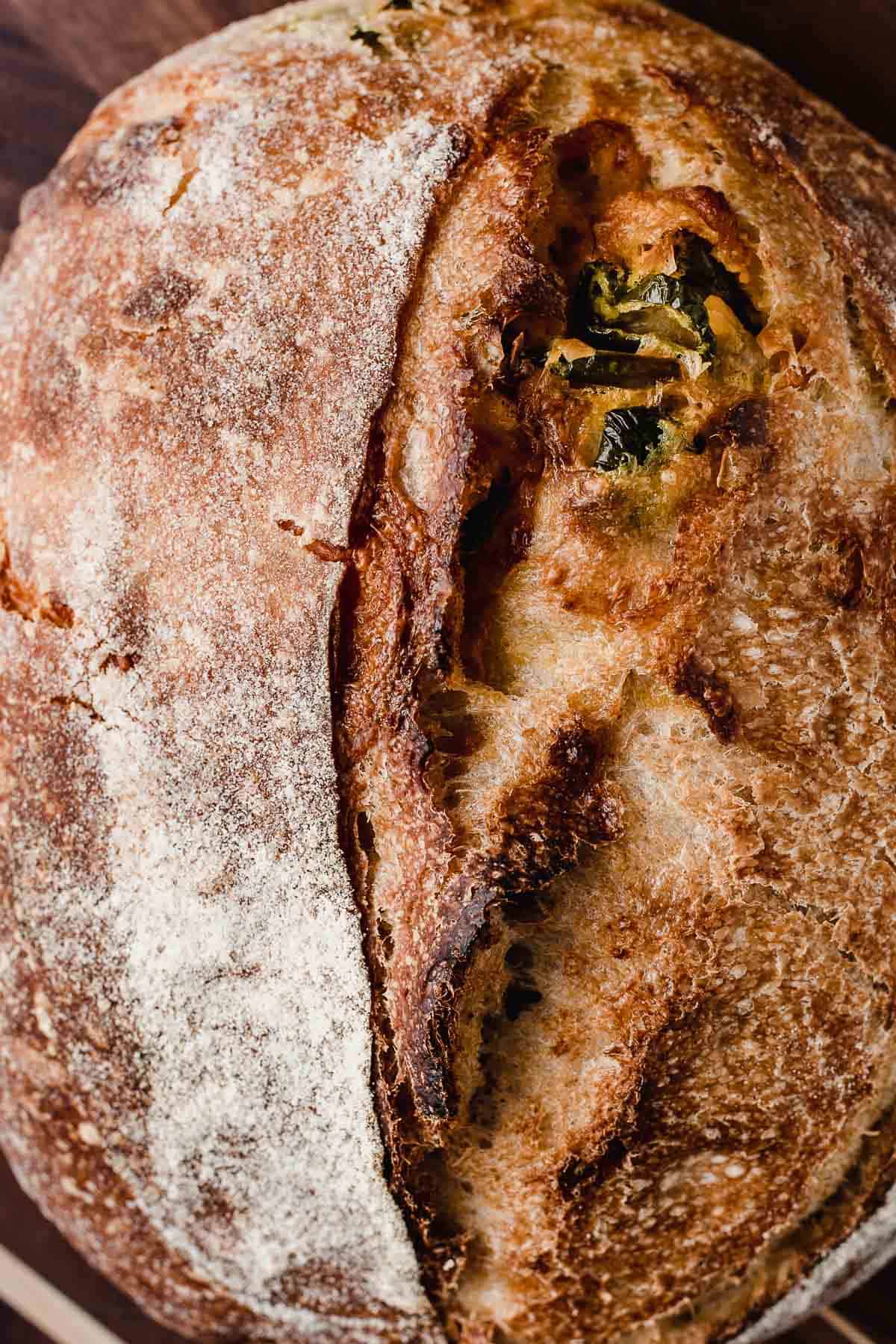
This is our basic sourdough country loaf recipe with the addition of shredded cheddar cheese and pickled jalapeños, which are added to the dough in the second set of stretch and folds.
Fresh jalapeños can be used in place of pickled jalapeños if desired. If you prefer the bread to be less spicy, remove the seeds before adding the peppers to the dough.
Jalapeño cheddar sourdough bread can be enjoyed alongside soups, as the base for a spicy grilled cheese sandwich or on it’s own for a tasty snack!
Sample baking schedule
For reference, my kitchen temperature is 70°F. Each step can be affected by the temperature of your kitchen. If your kitchen is colder than 70°F, the process will take longer and vice versa.
Every step in the schedule is performed at room temperature.
- 8 PM: The night before you mix the dough, feed the sourdough starter so it is active and bubbly in the morning.
- 8 AM: In the morning, mix the flour, water and the starter in a mixing bowl. (Reserve 30 grams of water for next step.) Cover and let the dough rest for 1 hour.
- 9 AM: Mix the salt and remaining water into the dough with your hands. Cover and let rest 1 hour.
- 10 AM: Perform the first set of stretch and folds. Cover and let rest 30 minutes.
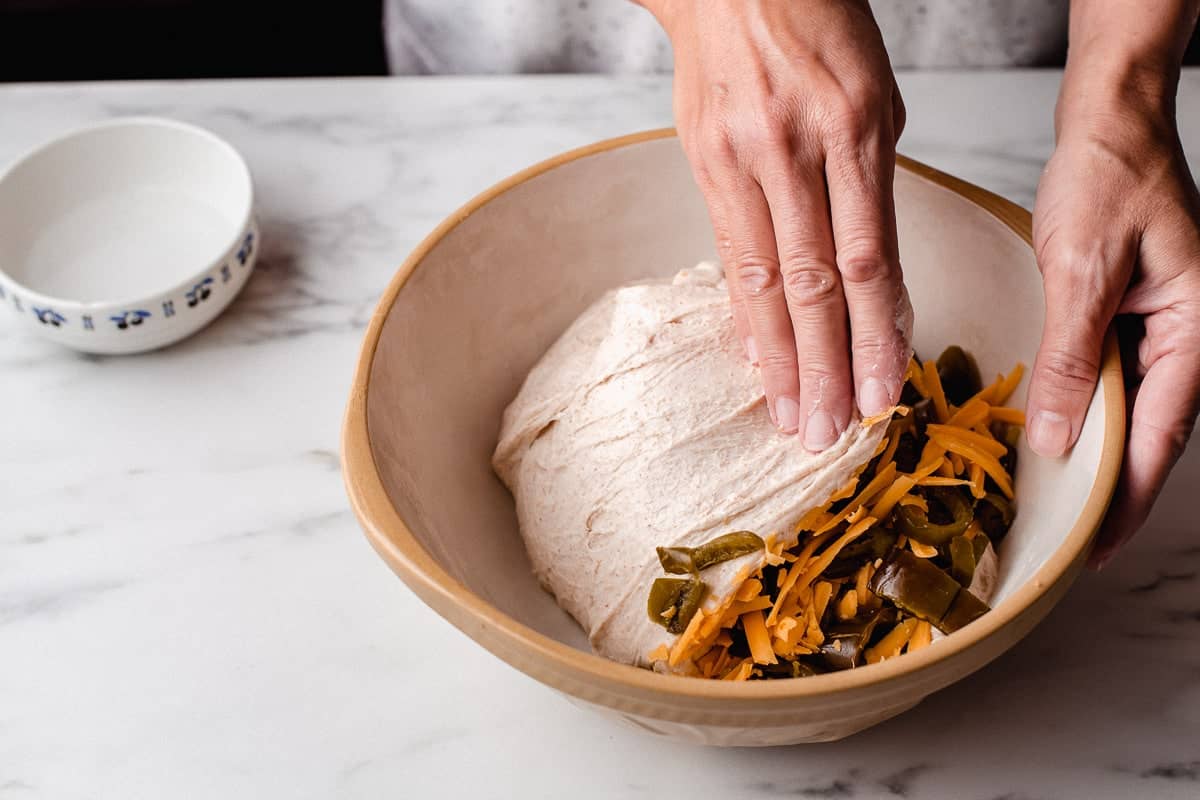
- 10:30 AM: Add the shredded cheddar cheese and pickled jalapeños to the top of the dough and perform the second set of stretch and folds. Cover and let rest 30 minutes.
- 11 AM: Perform third set of stretch and folds. Cover and let the dough for rest 2.5 hours.
- 1:30 PM: Dump the dough onto floured surface and shape it into a ball. Place it upside down in floured proving basket. Cover and let rise 2-2.5 hours at room temperature.
- 4 PM: Preheat the oven, score and bake. Allow the bread to cool down for 2 hours before slicing.
Tip: After placing the dough in the proving basket, you have the option to cover it and let it cold ferment in the fridge for up to 36 hours.
When you are ready to bake, preheat the oven and bake according to recipe directions. There is no need to let the dough rest at room temperature before baking.
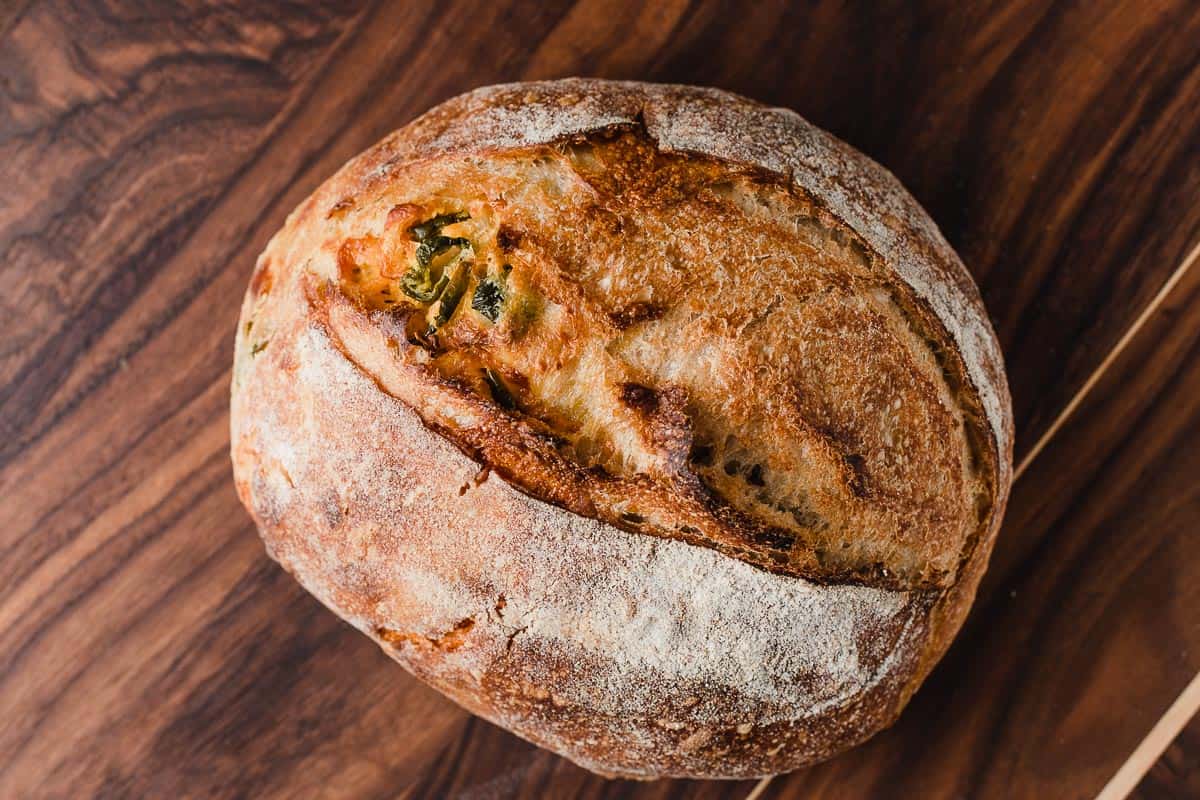
Tips on shaping the loaf
Normally, when shaping sourdough, the dough would be shaped twice, a pre-shape and a final shape. However, this dough is shaped once, in the pre-shape method.
- After dumping the dough onto a floured surface, use your hands to gently pull and twist it on the surface to form a rough shaped ball or oval shape.
- Flour the top of the dough and use a bench scraper to pick the dough up and turn it over into a floured proving basket.
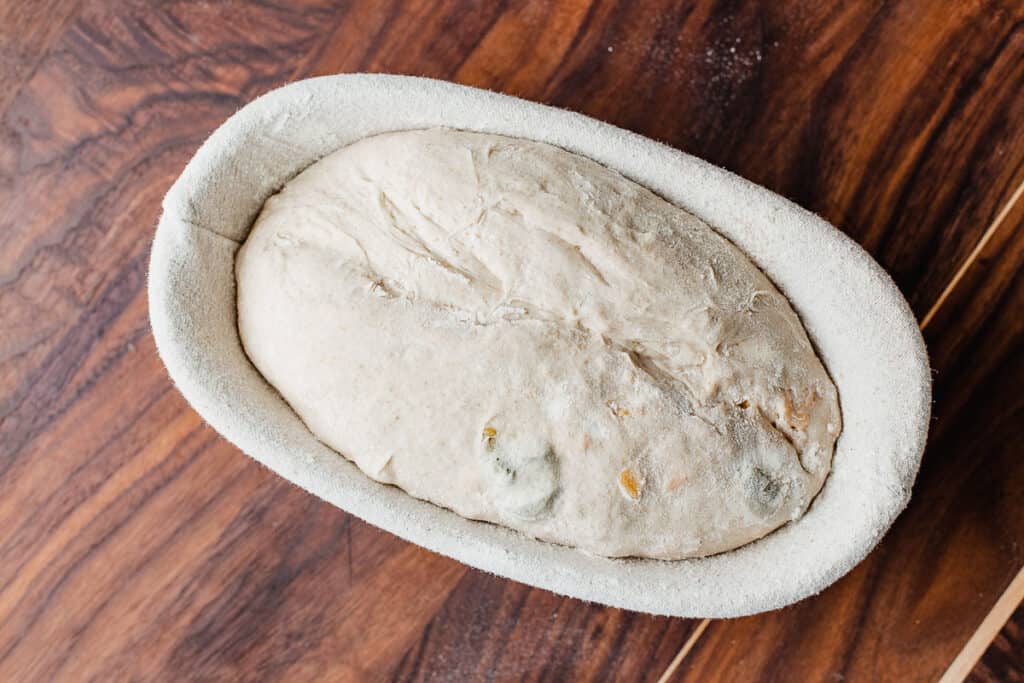
Do not worry about creating a "taut" surface on the outside of the dough when shaping. Because of the added cheese and jalapeños, the skin is easier to break when shaping, so be gentle.
How to store and freeze sourdough
Store your jalapeño cheddar sourdough bread at room temperature in a bread bag, wrapped in a kitchen towel or beeswax wrap. You can also store the bread, sliced side down, on a cutting board, covered with the dome of a cake stand.
It is not recommended to store sourdough bread in the fridge as it will become hard.
Freeze full loaves or individual slices wrapped tightly in plastic wrap and inserted into a freezer-safe container for up to 3 months.
How to measure flour without a scale
Because flour is measured by weight, if the flour is scooped straight out of the bag with the measuring cup, there will be more flour than called for in the recipe.
- Use a spoon to fluff up the flour in the bag.
- Use the spoon to scoop the flour into a measuring cup until it is heaped on top.
- Take a butterknife and level off the top.
This should give you the most accurate measurement for flour without a scale.
Tips for baking in warm and/or high humidity
When baking in warm and/or high humidity areas, it's often a good practice to use less water and bake a little longer than the recipe calls for.
Reduce the water by 50 grams in the initial mix and then slowly add the remaining water until you achieve the correct hydration level. Bake the bread about 5-10 minutes longer with the lid on, before removing for the remaining bake time. This will take some trial and error!
High altitude baking tips
If you live at a high altitude, 5,000-11,500 feet above sea level, you will need to use a sourdough recipe developed for high altitude baking for best results. Visit Butter and Air for their expertise on high altitude sourdough.
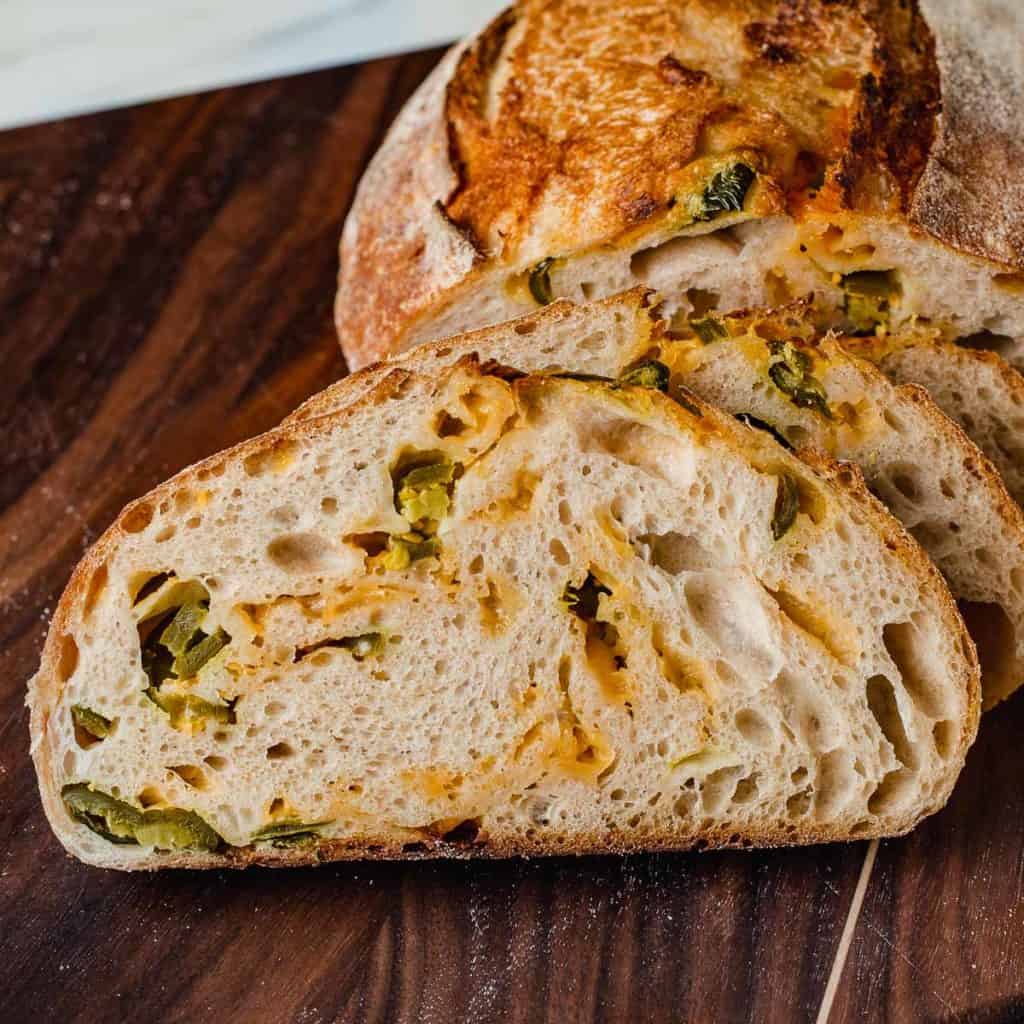
Easy sourdough bread recipes
Sourdough baking doesn't have to be complicated. Follow one of our easy, step-by-step sourdough recipes for perfect results every time!
- cinnamon raisin sourdough bread
- honey wheat sourdough sandwich bread
- sourdough bagels
- soft sourdough pretzels
- olive and walnut sourdough bread
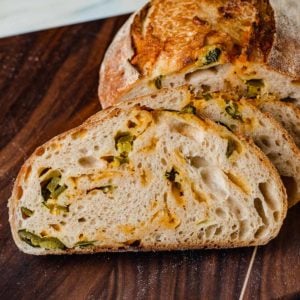
Jalapeño Cheddar Sourdough Bread Recipe
INGREDIENTS
Ingredients to make ½ cup (100 g) of Active Sourdough Starter
- 1 tablespoon (15 g) sourdough starter
- ⅓ cup + 1 tablespoon (50 g) all-purpose flour
- 3 ½ tablespoons (50) water
Dough Ingredients
- ½ cup (100 g) sourdough starter (active)
- 1 ½ cups (360 g) water (30 grams divided)
- ⅓ cup + 1 tablespoon (50 g) whole wheat flour
- 3 ¾ cups (450 g) bread flour
- 2 teaspoons (10 g) fine sea salt
Add-in Ingredients
- ¼ cup (60 g) sliced jalapeños (pickled or fresh)
- 4 oz. (113 g) sharp cheddar cheese (shredded)
INSTRUCTIONS
Feed Your Sourdough Starter
- 12 hours before you plan to mix the dough, add the ingredients to make ½ cup (100 g) of active sourdough starter to a clean jar. Stir until combined, loosely cover the jar and let the starter rise at room temperature. (This will create a total of 115 g active starter but some of it will stick to the sides of the jar during the transfer, so we are making a little more than needed.) The sourdough starter is ready to use when it has doubled in size and there are plenty of bubbles on the surface and sides of the jar.
Make the Dough
- Autolyse: In a mixing bowl, combine 330 grams of water and 100 grams active sourdough starter, stir to combine. Add 50 grams whole wheat flour and 450 grams bread flour and use your hands to combine the ingredients until there are no dry bits and the dough looks like a shaggy mass. Cover the bowl and let the dough rest on the counter for 1 hour.
- Add salt: Add 10 grams of salt to the remaining 30 grams of water in a small bowl and stir to dissolve. Add the salt water to the dough and use your hands to work it in until well combined. Cover the bowl and let rest on the counter for 1 hour.
- Bulk fermentation: Perform 3 sets of stretch and folds, 30 minutes apart, over the first hour and a half. Add the shredded cheddar cheese and jalapeños to the dough during the second set of stretch and folds. Keep the bowl covered between sets. Once finished with the third set of stretches and folds, cover the dough and allow it to rise at room temperature for an additional 2-3 hours. How to perform a set of stretches and folds: While the dough is still in the bowl, pick up one side with a wet hand. Pull it up and over itself. Turn the bowl and repeat this action on 4 sides of the dough until the bowl has come full circle.
- Shape and Second Rise: Turn the dough onto a floured surface and shape it into a rough ball. (The outside of the dough will not be smooth). Flour the top of the dough and place into a floured proving basket, top-side down. Allow to rise at room temperature for 2-3 hours or until it has risen about 20%-30%.(Alternatively, you can cover the shaped dough and let it rest in the fridge for up to 36 hours.)
- Preheat: Preheat the oven, with the dutch oven inside, to 500° for 30 minutes.
- Score and Bake: Turn the dough out onto a piece of parchment paper and score the top with a razor. Remove the dutch oven and place on stove-top. Use the parchment paper as a sling and lift the dough up and into the dutch oven. Cover with the lid, turn oven down to 450° and bake for 30 minutes. Remove the lid and bake an additional 20-25 minutes or until the crust is at the desired color.
- Cool: Let the bread cool on a cooling rack for 2 hours before cutting.
NOTES
- Use large silicone gloves when bread baking to protect hands and forearms from burns.
- During the first rise (bulk fermentation), if your kitchen temperature is warmer than 70°, check the dough 2 hours after the last stretch and fold to make sure that it does not over proof. The dough is ready for shaping when it has risen about 30% and has bubbles around the edges of the bowl.

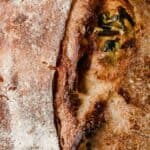


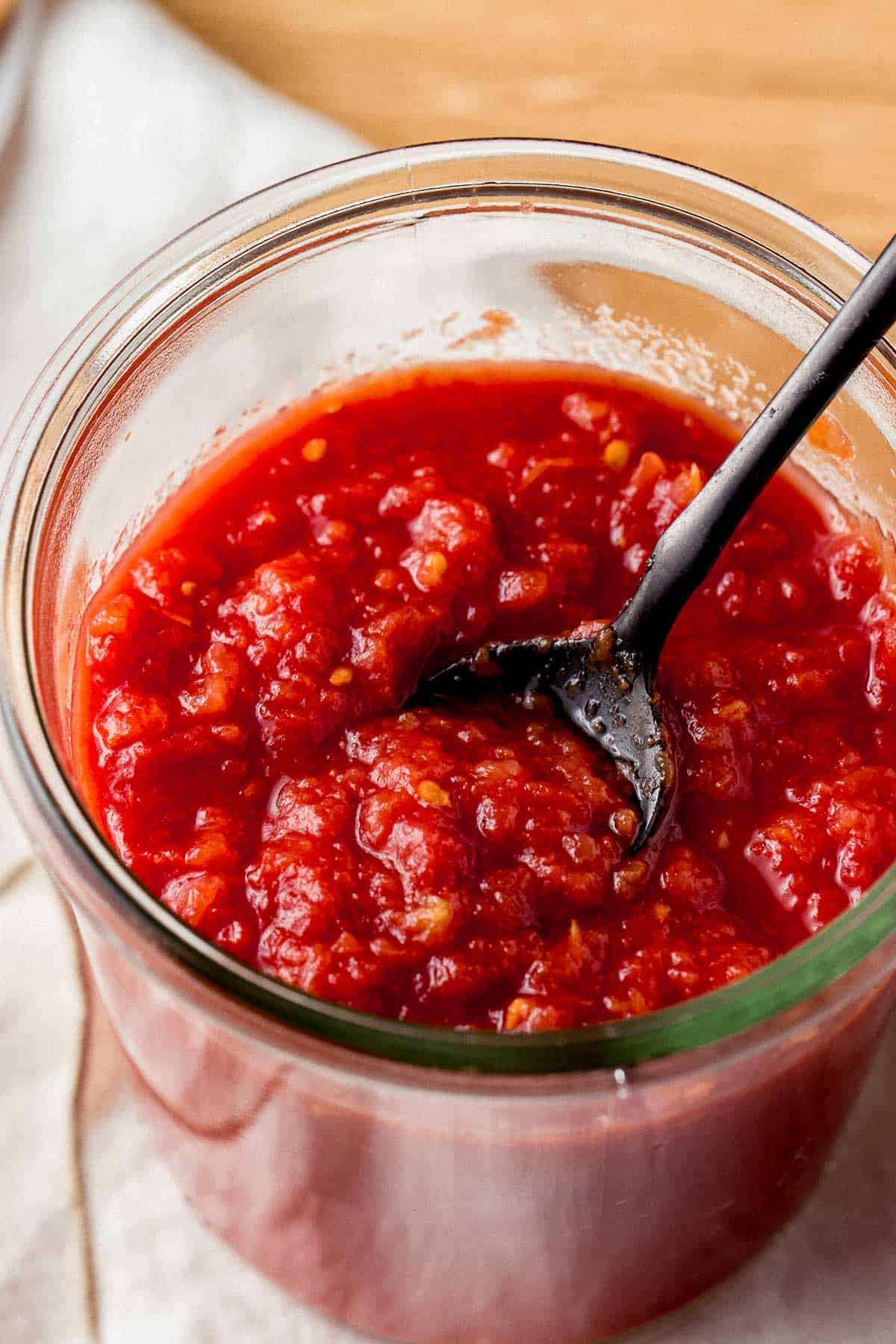
Michelle Conable says
Finally perfected sourdough with this recipe. It’s more fail proof than basic recipes. The only thing I would recommend is to get your jalapeños and cheese to room temperature to not slow your rise.
Christie Matthews says
Made this a few times now and it’s absolutely Devine. Thank you!